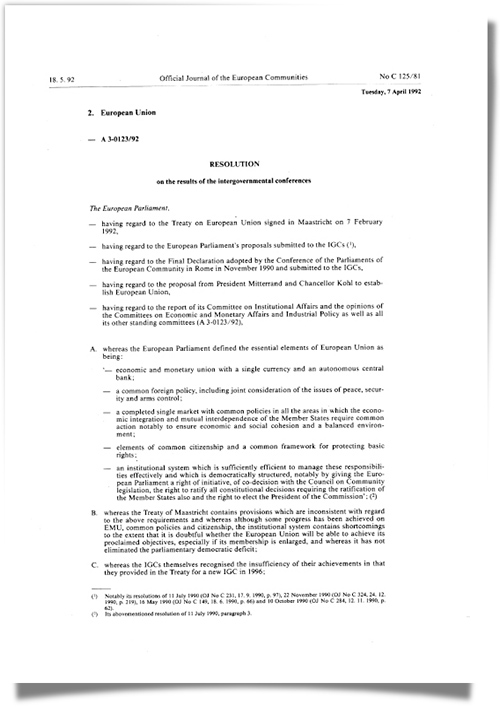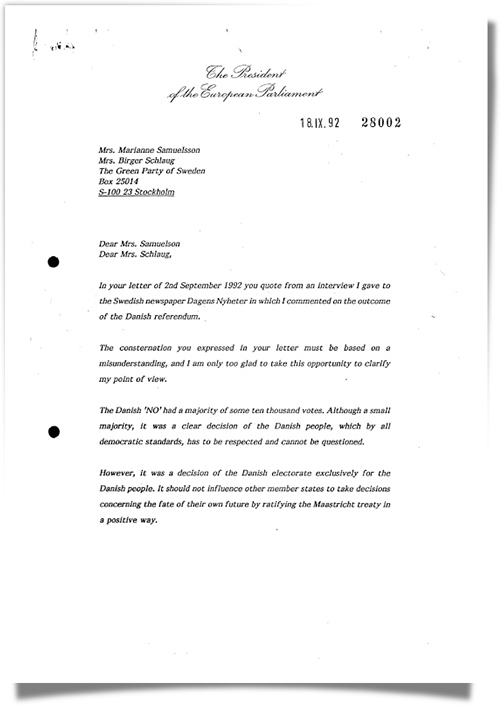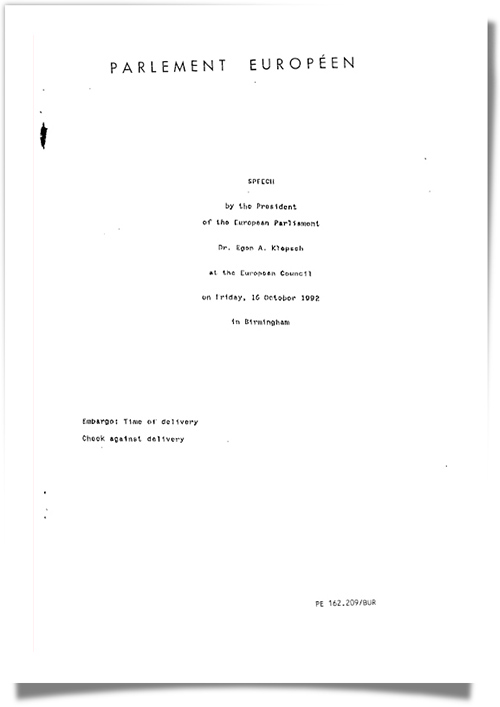The year 1992 marked a turning point in the construction of the European Union with the signature on 7 February of the Maastricht Treaty (Treaty on European Union - TEU). This Treaty introduced a new structure for cooperation between Member State governments based on three ‘pillars’: grouping the original EU organisations into the European Communities, common foreign and security policy, and cooperation in the field of justice and home affairs. This established the European Union (more information on the Maastricht Treaty here).
 Signature ceremony of the Treaty on European Union in Maastricht on 7 February 1992 © European Communities, 1992
Signature ceremony of the Treaty on European Union in Maastricht on 7 February 1992 © European Communities, 1992
It was against this historic background that Egon Klepsch was elected President of the European Parliament on 14 January 1992. His duties regarding the “completion of European Union, and beyond this the unification of Europe” and his awareness of the enormity of the task facing all concerned in bringing this “ambitious project” to a successful conclusion were a key theme of his inaugural speech.
“The Maastricht Summit was a milestone, but we must not stop to rest on the way...I am confident that the Community will achieve this goal speedily and with determination”
 Inaugural speech by President of the European Parliament Egon Klepsch (Download the speech here - PDF)
Inaugural speech by President of the European Parliament Egon Klepsch (Download the speech here - PDF)
Yet before the Treaty could come into force, it had to be ratified by all the Member States. The European Parliament voted in favour of its ratification and urged, in its resolution of 7 April 1992, the national parliaments to ratify the Treaty, bearing in mind its positive aspects. However, the Parliament also set out a list of the Treaty’s failings, notably in relation to the roles the European Parliament and the Commission would play in the intergovernmental ‘pillars’ and in economic and social policy.
 European Parliament resolution on the results of the of Intergovernmental Conferences, 7 April 1992 (Download the document here - PDF)
European Parliament resolution on the results of the of Intergovernmental Conferences, 7 April 1992 (Download the document here - PDF)
It would be almost two years before ratification was completed. The first setback occurred in Denmark, where Danish citizens rejected the treaty by 50.7% in a referendum, plunging the ratification process into crisis. In France, the ‘yes’ vote won narrowly in a referendum on 20 September. In Great Britain, the Euro-sceptics threatened to go to the Court to hold back ratification on the pretext that a formality had not been respected.
The tension at the end of 1992 was palpable, as can be seen from letters between Klepsch and representatives of the Danish Green Party, following publication of an interview with the European Parliament President in a Swedish newspaper.
“It was a decision of the Danish electorate exclusively for the Danish people. It should not influence other member states to take decisions concerning the fate of their own future by ratifying the Maastricht treaty in a positive way”
 Correspondence: Statement by Klepsch following the Danish referendum on the Maastricht Treaty (Download the document here - PDF)
Correspondence: Statement by Klepsch following the Danish referendum on the Maastricht Treaty (Download the document here - PDF)
In his speech to the extraordinary European Council of 16 October 1992 in Birmingham, President Klepsch set out his position on the problems encountered in successfully completing the ratification process. Referring to the resolution adopted by a large majority two days earlier in the European Parliament (link to the resolution here - PDF), he urged the Heads of State or Government to increase transparency and strengthen democracy in the Community. He proposed to create a more positive image of the European Community, reminding the public that the European unification process was “founded on the principles of openness, subsidiarity and democracy” and on “restoration of public trust in politics.”
“We must inform our citizens fully about our intentions and actions and at the same time frame our policies in such a way that people can understand them. It is only by doing so that we will gain the necessary acceptance, which will enable us to achieve the European Union and thus contribute to peace and freedom in Europe and in the world”
 Speech by the President of the European Parliament in Birmingham (Download the document here - PDF)
Speech by the President of the European Parliament in Birmingham (Download the document here - PDF)
When the second referendum was held on 18 May 1993, Denmark approved the Maastricht Treaty by a majority of 56.8% of the votes.
The Treaty on European Union came into force on 1 November 1993.
